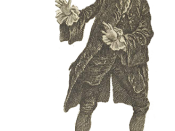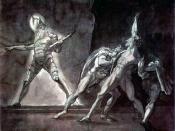This essay is an attempt to answer why audiences respond more strongly to watching people interacting in a three dimensional space than on the screen. The keyword is the body.
Let's start with an example of the dumb-show in Hamlet. At the end of the dumb-show Ophelia asks:
OPHELIA What means this, my lord?
HAMLET Marry, this is miching malicho. It means mischief.
Ophelia has difficulty in understanding the dumb-show and asks Hamlet, the director, for interpretation, which implies that the actor's body can only "mean" something if it can be translated into words. This is the moment where the question of the meaning of body is raised. Hamlet's opaque answer seems to say: "you make sense of it" and the fact that the phrase "miching malicho" is deliberately left untranslated implies that any audience will have to work out what the show means without Hamlet's explanation.
THE BODY DISCURSIVE thus implies the body being realized through words, the body given interpretation by the text.
The best examples of the body discursive normally occur at a spatial or temporal distance. Gertrude's portrait of drowned Ophelia ('Her clothes spread wide, / And mermaid-like awhile they bore her up ...' 4.7.175) is an offstage scene frequently visualized or 'embodied' in paintings. Another good example is the case of Polonius whose body becomes a major point of reference only when dead and offstage.
The words of the text have another function and that is to create a bridge between the actor and the world of dramatic fiction by alluding to what the body of the actor must do in performing the character. This process can be reversed and the body can give meaning to the text where too much deixis (words such as I, here, now and demonstratives this and that etc.) obscures...


